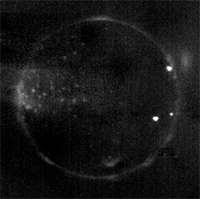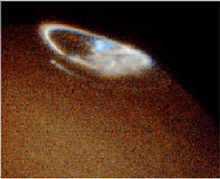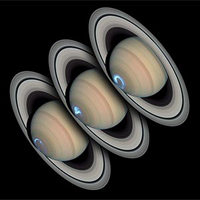Auroras can be found in the upper atmospheres of other planets in our solar system. Below you will find some images of such aurora. In the Links Section to the left, you will find links to articles about the magnetospheres of other planets and their auroras. The dynamics of aurora, such as the evolution in substorms, can help scientists learn about how a planets's magnetosphere processes solar wind energy. Because the particles that collide with the gas in an atmosphere follow magnetic field lines, we can also learn more about planets' magnetic characteristics by studying auroras.
NASA's May 1st, 2007 News Release about Io's auroras further explains aspects of auroral dynamics.
An auroral glow, produced as intense radiation from Jupiter's magnetosphere bombards Io’s atmosphere, outlines the edge of the moon’s disk. The glow is patchy because the atmosphere itself is patchy, being denser over active volcanoes. In addition to the near-surface glow, there is a remarkable auroral glow suspended 330 kilometers (200 miles) above the edge of the disk at the 2 o'clock position; perhaps this glowing gas was ejected from the new volcano below it. Another glowing gas plume, above a fainter point of light, is visible just inside Io's disk near the 6 o'clock position; this plume is above another new volcanic eruption discovered by New Horizons.
On the left side of the disk, near Io's equator, a cluster of faint dots of light is centered near the point on Io that always faces Jupiter. This is the region where electrical currents connect Io to Jupiter's magnetosphere. It is likely that electrical connections to individual volcanoes are causing the glows seen here, though the details are mysterious.
 |
Io in Eclipse. Photo credit: NASA/Johns Hopkins University Applied Physics Laboratory/Southwest Research Institute |
 |
A Hubble Space Telescope image of the Jovian aurora. |
 |
An aurora on Jupiter (credit: John Clarke - Univeristy of Michigan) |
 |
An image sequence of an aurora occuring on Saturn (credit: NASA, ESA, and John Clarke - Boston University) |
 |
An artist's cpnception of Saturn Aurora (credit: NASA, ESA, and A. Schaller) |



